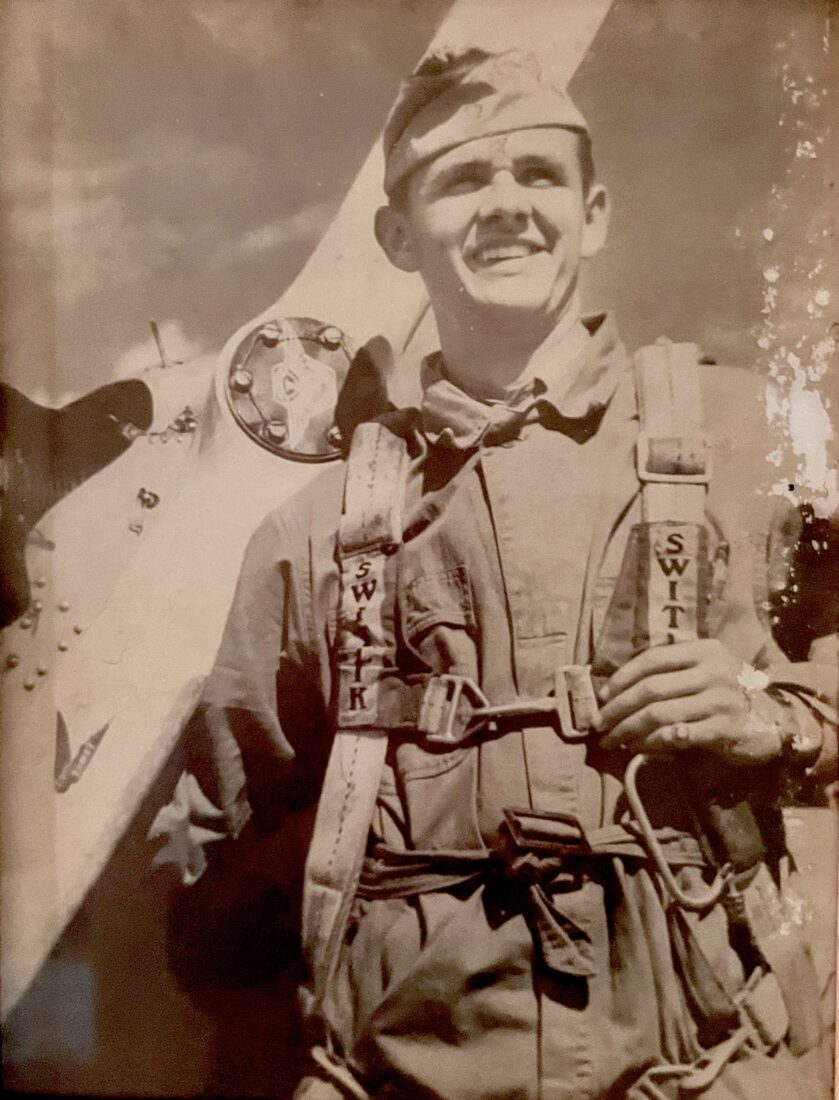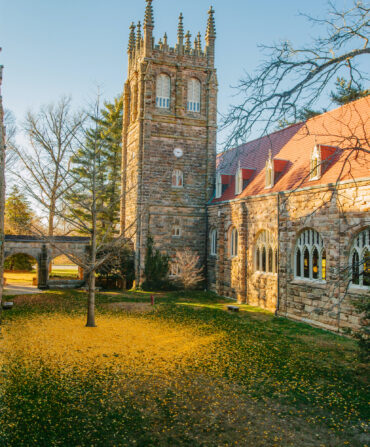Bob Lowdermilk still lives in his hometown of Mount Gilead, in the Piedmont of North Carolina, where he was born in March 1924—in fact, in the very same house he arrived in a hundred years ago. But he’s experienced several lifetimes in the century in between, from fighting in World War II, to serving forty years on active duty and in the reserves, to working in the aeronautics industry, to building a life abroad and at home with his wife and family.
Last year, his community honored the retired lieutenant colonel, now one of the last surviving P-38 fighter pilots, with a mural in Mount Gilead by the brothers and artists Jack and Eli Williams, depicting Lowdermilk as a young aviation cadet. In a story covering the mural in the local Montgomery Herald, Eli called the project “a little nerve-wracking, because everyone knows him, so it’s got to be good.”
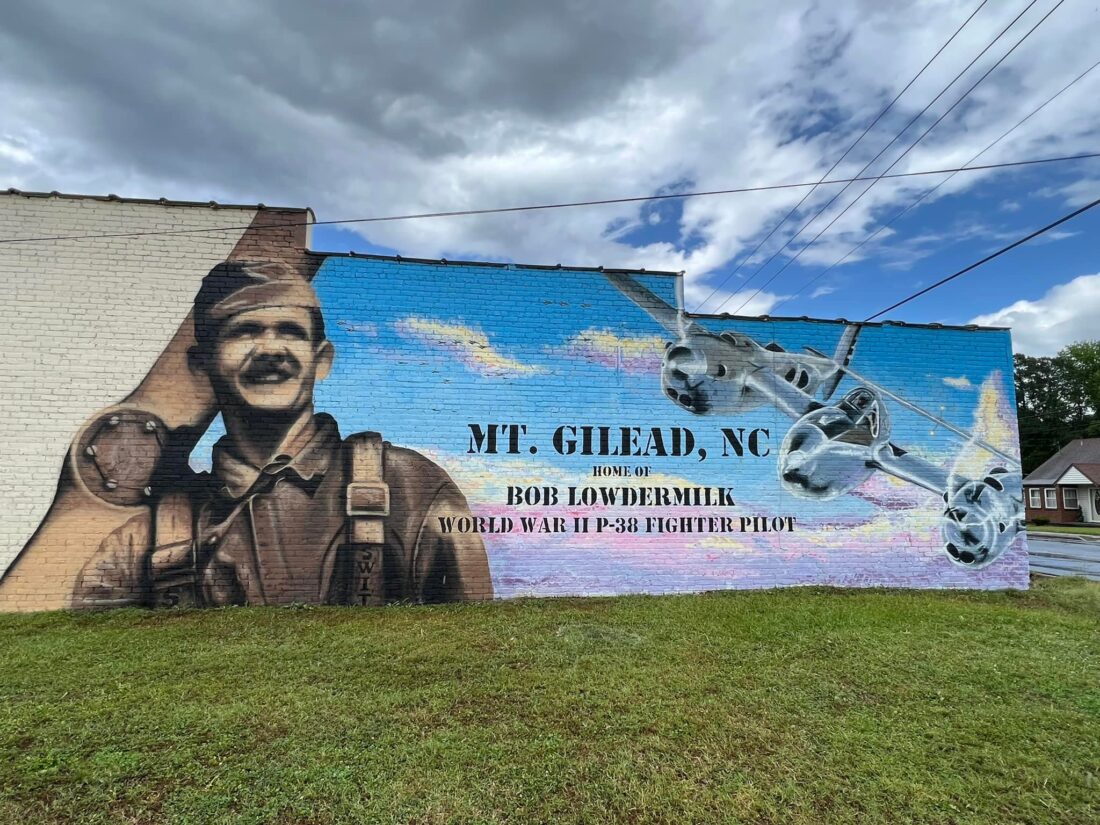
Here, the locally beloved Lowdermilk shares his still-sharp memories, including the devastation he witnessed as a World War II fighter pilot, and the wisdom earned from a century of living.
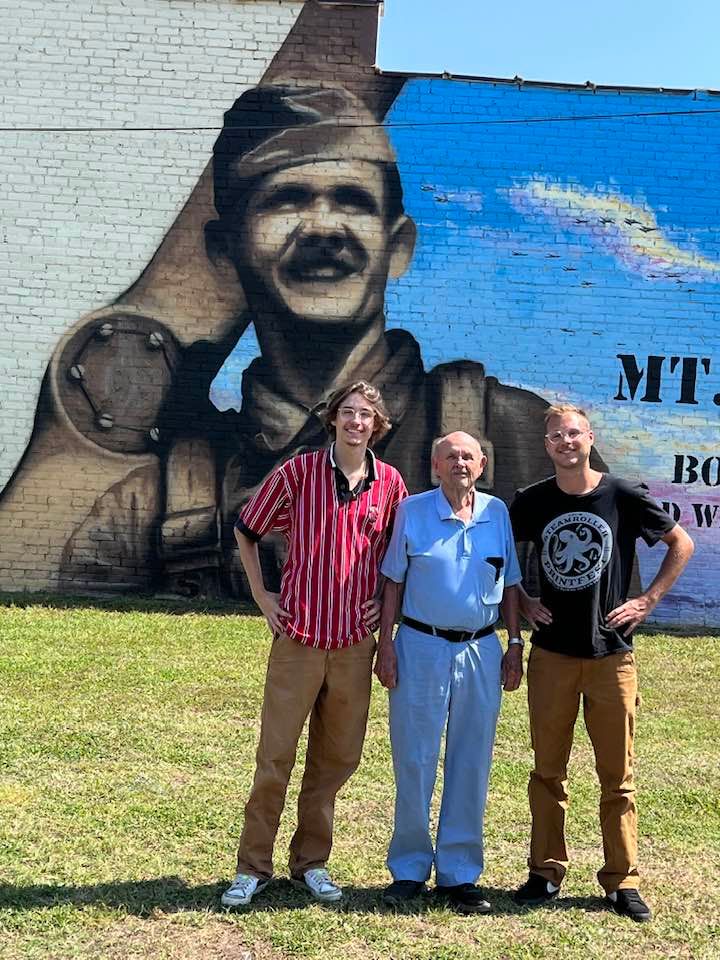
On his early years: “I was born in this house. I’m a little younger than the house—it was built in 1915, and I was born in ’24. In ’41, I graduated from Mount Gilead High School and went to North Carolina State and enrolled in electrical engineering at seventeen years old. We didn’t have but eleven grades back then.”
On Pearl Harbor: “December 7, 1941—it was a Sunday afternoon. I was actually in my room studying for final exams when I heard the announcement [of the bombing]. I went on and finished my freshman year, but in 1942, they lowered the draft age to eighteen. I had just turned eighteen, so I had to register. I was drafted in February of ’43 during my sophomore year at State. [I was part of the] first group of eighteen-year-olds drafted from Montgomery County.”
On training for World War II: “About halfway through my sixteen weeks of boot camp, an order or memo came out that anybody in the military could apply for pilot training. I was sent to the University of North Dakota at Grand Forks. There we studied physics, meteorology, aerodynamics, Morse code.
“One thing I never understood, when we went in to talk to the psychiatrist, we had to go in barefooted. No socks or anything. One of the cadets that went in was talking to the psychiatrist. And the psychiatrist took out a pad and drew some scribbling on it and said, ‘What does that remind you of?’ And the cadet said, ‘Sex.’ So he took another sheet and did some scribbling on it. ‘What does that remind you of?’ He said, ‘Sex.’ The psychiatrist said, ‘You’re a little obsessed with sex, aren’t you?’ He said, ‘Doc, it’s not me. You’re the one drawing the dirty pictures.’
“The first fighter I flew was the P-39. This was in Victorville, California, next to the Mojave Desert. We had no official training program. We just were told to read the manual. You get in the cockpit and fly and do what you wanted. I passed all those tests, and then they sent me to primary training at Ryan Field out of Tucson, Arizona. [They used an] open-cockpit, two-seat plane for our primary training. A BT-13. There we started formation flying and a little advanced flying, little acrobatics, instrument flying.
“After we graduated and were commissioned to second lieutenant and given our wings at Luke Air Force Base, in Phoenix, they divided the group into ones who were going to fly bombers, or fighters, or transport, and I was assigned to fly fighters. I was eventually sent to Van Nuys, California, to really start fighter training in the P-38. And that’s the plane on the mural.
“We finished there in December of 1944. They didn’t have an opening anywhere for pilots then, so we transferred to Santa Maria, California, for a month, just to keep our flying skills up, and then to Chico. There, they had a jet squadron that was training—the P-59, which was the first [American] jet fighter ever made. We used to dogfight with them. But we were a little faster than the jets at that time. Then I finally got my orders to go overseas.”
On the invasion and occupation of Japan: “I joined the 49th Fighter Squadron in the Philippines, and this was in 1945, July, I believe. It took forty hours of flying time in the C-54 from San Francisco to Manila. From there, I was assigned to the 49th Fighter Group. We had already conquered the Philippines essentially, but they still had some resistance in the hills. They would call on us to either drop napalm on it or do some strafing, so that’s what we did there. [And we’d go on] surveillance missions around the island of Hokkaido, Japan, which was about two-hundred miles across. We’d kind of circle the island, just let them know we were there.
“Our airstrip [in Manila] was right on the gulf. I used to be able to pick out my tent. We lived in the open air, of course. We used to tie guard monkeys to our tents. It would chatter when something would come around.
“I was on Okinawa when they dropped the atomic bomb on Hiroshima, which probably saved my life. As I understand, we were scheduled to back up the invasion of Korea at the same time they had the atomic bomb. The 49th Fighter Group was going to invade Japan and Korea at the same time. And it’s rumored it was in November of 1945 that this was supposed to take place.
“I flew over Hiroshima, weeks or so after the bomb was dropped, and it was complete devastation for a mile diameter, at least. We couldn’t judge exactly, but that destruction wasn’t anywhere near as bad as in the industrial complex between Yokohama and Tokyo that had been completely destroyed by bombings. In fact, in March of 1945, they had a firebomb raid on northeast Tokyo from B-29s that burned out the whole northeast part of Tokyo. It was estimated that over a hundred thousand people were killed in that raid. The Japanese residential construction was very flammable, and it burned completely. And you might ask, why would the United States bomb a residential area? At that time, the assembly plants in Japan had mostly gone underground, but they had small shops throughout the residential area building parts to supply the assembly plants. So they wanted to cut off that supply.
“The most memorable experiences, I think, was seeing Hiroshima and escorting the Japanese delegates to the island of Ie Shima [known as Iejima] for the surrender, and occupying. The Japanese decided to surrender, and they sent a delegation to Manila to meet with [General Douglas] MacArthur to work out the details. The 49th Fighter Group escorted two Japanese bombers. We called them belly bombers. They were marked with a green cross for identification, and we escorted them to Ie Shima, about eight miles off the coast of Okinawa.
“We went into Japan [afterward] as the occupation force, in September of 1945. And the rest of my [active] military career was in the occupation of Japan. They had no [plane] hangers or anything. We had steel mats built over rice paddies. The runway was steel mats. As soon as they had an airstrip on Okinawa, they transferred our group there. From there, we could do strafing missions into southern Japan. We couldn’t carry bombs because we had to carry belly tanks for fuel.
“We would strafe in airfields and so forth. At this time, the Japanese were not putting up any fighters, except the kamikazes. It was getting towards the end at that time. So we had no aerial combat. The Japanese were very vicious during the war. They tortured prisoners and everything, but during the occupation, as far as I know, we never had any problems. They were very—I won’t say hospitable, but, from my experience anyway, they were very nice to us.
“We had a Christmas party in Japan in 1945, and our group commander cut the cake with a Japanese sword. At that time, all the young guys that didn’t have enough points to come home, they sent us to Hokkaido. We had it real good; we took over a barracks the Japanese had, and it was well heated. My first hot bath in six months. Oh my goodness. Yeah, we were all happy about that. I halfway learned to ski there.
“I was there up until July of ’46 and I was able to come home. I got on a ship to come back to the States. We had two or three days before I could get a troop train to go back to Fort Bragg [in North Carolina], so we took in a nightclub. This was in San Francisco, and there was this famous fan dancer, Sally Rand. We asked if we could take a picture with her to send back to the ones we left over in Hokkaido. She agreed, so we took a picture.”
On marriage: “My wife, Margaret, was from Pageland, South Carolina. We met on a blind date. I’m not fond of blind dates. This friend of mine asked me to date this girl who had just come into town to visit her sister and go to the movies in Albemarle. I said, ‘No, I have to babysit.’ Later that day, I was downtown, [being a] drugstore cowboy [loafing in drugstores], and I saw this young girl pushing a baby carriage. She had on shorts, and was real pretty. I called my friend back and said, ‘If that was the girl you wanted me to date, I don’t have to babysit.’ I had had quite a few dates in my life, but this one hit. She was quite a woman. She was pretty; she was smart; she had a good personality, so I fell for her.
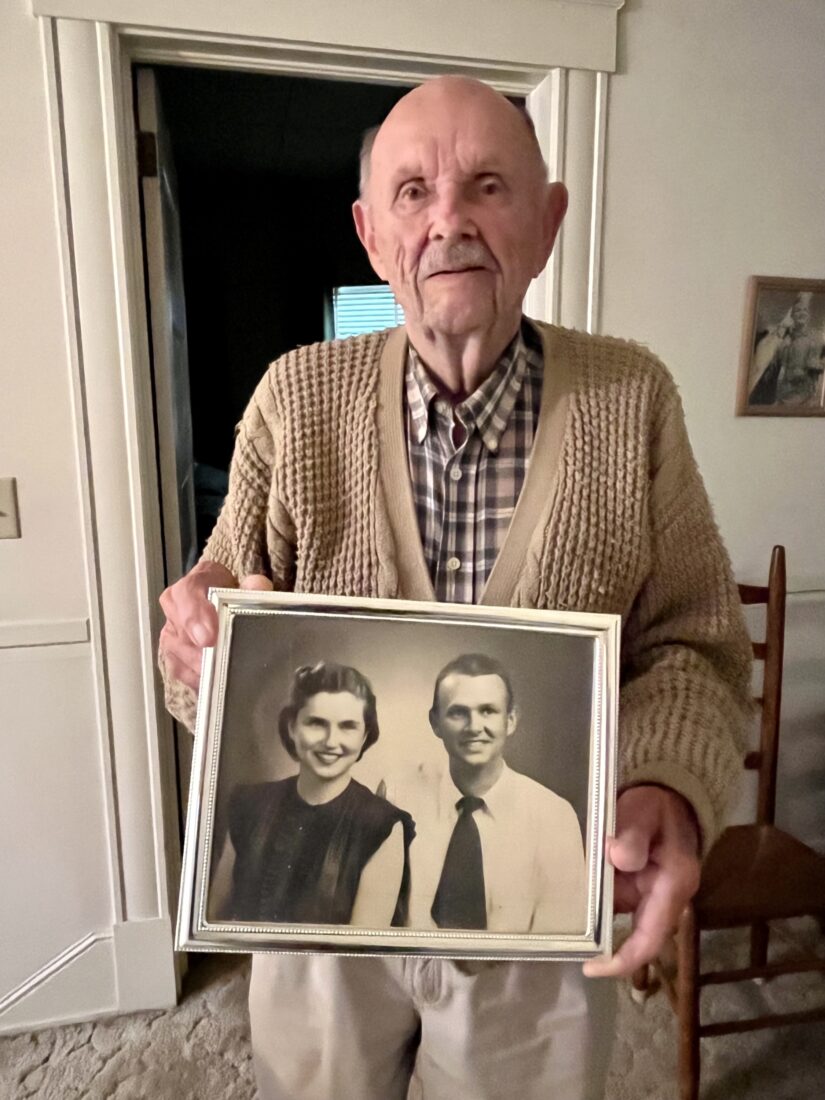
“I didn’t get paid for a year when I was overseas in the military, so [when I did finally get paid] I had a little cash. I bought a ’41 Mercury convertible. That was hot stuff. We dated in that, but I had dated women before, and so one of the first things she wanted to do was trade that car in. She thought there were too many stories in there. She talked me into trading it after we married—we got married a week after I graduated college in aeronautical engineering in ’49. Her parents thought she had married a boy. I didn’t have a job.”
On turning service into a career: “We came back from our honeymoon, and I had a telegram that said there was a civil service job available at Wright Field [near Dayton, Ohio]. The telegram said, the money for your job has not been appropriated, but we’re sure we can place you within six months, and here I was just married. So I started looking for a job.
“The Charlotte Observer had an ad for a high school math teacher and assistant coach in Fairmont, North Carolina. I said, shoot, I can teach math. I was fairly athletic in those days. I applied, went down to Fairmont for an interview on Monday, and Tuesday I was teaching school. I taught for five years, and then I got into the aerospace business, into my degree stuff, so I went with Lockheed [Martin] in Marietta, Georgia.
“I’ve been all over the world in business. In fact, one business trip I had, I flew around the world. I was living in Connecticut, so I flew out of New York. I had to go to Bangkok, Thailand, so I flew from New York to Anchorage, Alaska, to Tokyo, to Bangkok. I spent a week there. We also had business in Yugoslavia, and on my way home I had to go by there, so I went from Bangkok, to New Delhi, to Athens, to Belgrade, to Yugoslavia, to Frankfurt, Germany, and back to New York.
“I think [the military] is a good occupation. It’s not suitable for everybody, I’m sure, but you get a lot of training, you learn a lot of things, you go to a lot of places, you make a lot of friends, and I won’t say the pay is good, but it’s livable. I would not hesitate to recommend anybody to make a military career, but it is dangerous.”
On his generation: “Well, we were put through a lot, I would say that. We went through the Depression and then the War. And we survived again. With all of the new technology, I don’t think we could bring too much to the table. We didn’t have television until 1954. I think the work ethics in the thirties and forties were stronger than they are today. We didn’t have the distractions of social media and all that.”
On the secret of a long life: “Genes, I think, have a lot to do with it. And fairly clean living. I’ve stayed very active. Margaret and I were married almost seventy years, and that’s an accomplishment. We went on twenty-one cruises, so we had a good time. We danced at the senior center in Albemarle. We had a good life. Good. She was almost ninety when she died.
“I don’t know that I would change my life. I like [living in a] small town. I lived all up [and] down the East Coast, from Connecticut to Georgia, South Carolina, Florida, Texas. I enjoyed all of them, but I hated to leave Charleston, South Carolina. I think we were lucky. I covered a lot of the world in the military, but I also covered a lot of the world in my business.
“I don’t know anything I was really proud of. I was proud to survive, for one thing. I had some good times as well as some bad times, but I made a lot of friends.”


